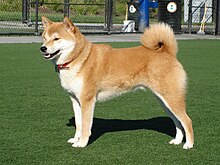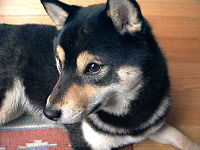Shiba Inu
A small, agile dog that copes very well with mountainous terrain, the Shiba Inu was originally bred for hunting.[1][2] It is similar in appearance to theAkita, though much smaller in stature. It is one of the few ancient dog breeds still in existence in the world today.
Description
Appearance
The Shiba's frame is compact with well-developed muscles. Males are 141⁄2 inches to 161⁄2 inches (35–43 cm) at withers. Females are 131⁄2 inches to 151⁄2 inches (33–41 cm). The preferred size is the middle of the range for each sex. Average weight at preferred size is approximately 23 pounds (10 kg) for males, 17 pounds (8 kg) for females. Bone is moderate.
Coat: Double coated with the outer coat being stiff and straight and the undercoat soft and thick. Fur is short and even on the fox-like face, ears, and legs. Guard hairs stand off the body are about 11⁄2 to 2 inches long at the withers. Tail hair is slightly longer and stands open in a brush. Shibas may be red, black and tan, or sesame (red with black-tipped hairs), with a cream, buff, or grey undercoat. They may also be white (cream), though this color is considered a "major fault" by the American Kennel Club and should never be intentionally bred in a show dog, as the required markings known as "urajiro" (裏白) are not visible; "Urajiro" literally translates to "underside white".[2] Conversely, a white (cream) coat is perfectly acceptable according to the British Kennel Club breed standard.[5]
The urajiro (cream to white ventral color) is required in the following areas on all coat colors: on the sides of the muzzle, on the cheeks, inside the ears, on the underjaw and upper throat inside of legs, on the abdomen, around the vent and the ventral side of the tail. On reds: commonly on the throat, forechest, and chest. On blacks and sesames: commonly as a triangular mark on both sides of the forechest.[6]
Temperament
Sometimes, the Shiba tends to show dog aggression. This is more prevalent between female Shibas and is influenced by the breed's strong prey drive. The Shiba Inu is best in a home without other small dogs or young children, but consistent obedience training and early socialization can make all the difference. The breed also interacts fairly well with cats.[2]
From the Japanese breed standard:
A spirited boldness, a good nature, and an unaffected forthrightness, which together yield dignity and natural beauty. The Shiba has an independent nature and can be reserved toward strangers but is loyal and affectionate to those who earn his respect. They can be aggressive toward other dogs.
The terms "spirited boldness" "good nature" , and "artlessness" have subtle interpretations that have been the subject of much commentary.[7]
The Shiba is a relatively fastidious breed and feels the need to maintain itself in a clean state. They can often be seen licking their paws and legs much like a cat. They generally go out of their way to keep their coats clean, yet thoroughly enjoy swimming and playing in puddles. Because of their fastidious and proud nature, Shiba puppies are easy to housebreak and in many cases will housebreak themselves. Having their owner simply place them outside after meal times and naps is generally enough to teach the Shiba the appropriate method of toileting.[8]
A distinguishing characteristic of the breed is the so-called "shiba scream". When sufficiently provoked or unhappy, the dog will produce a loud, high pitched scream. This can occur when attempting to handle the dog in a way that it deems unacceptable.[1][9][10] The animal may also emit a very similar sound during periods of great joy, such as the return of the owner after an extended absence, or the arrival of a favored human guest.
History
Recent DNA analysis confirms that this Asian spitz-type dog is one of the oldest dog breeds, dating back to the 3rd century BC.[3][11]
Originally, the Shiba Inu was bred to hunt and flush small game, such as birds and rabbits. Despite efforts to preserve the breed, the Shiba nearly became extinct during World War II due to a combination of food shortage and a post-war distemper epidemic.[1] All subsequent dogs were bred from the only three surviving bloodlines.[12] These bloodlines were the Shinshu Shiba from Nagano Prefecture, the Mino Shiba from Gifu Prefecture, and the San'in Shiba fromTottori and Shimane Prefectures.[4] The Shinshu Shibas possessed a solid undercoat, with dense layer of guard-hairs, and were small and red in color. The Mino Shibas tended to have thick, prick ears, and possessed a sickle tail, rather than the common curled tail found on most modern Shibas. The San'in Shibas were larger than most modern shibas, and tended to be black, without the common tan and white accents found on modern black-and-tan shibas.[4]When the study of Japanese dogs was formalized in the early and mid-20th century, these three strains were combined into one overall breed, the Shiba Inu.[4] The first Japanese breed standard for the Shiba, the Nippo Standard, was published in 1934. In December 1936, the Shiba Inu was recognized as a Natural Monument of Japan through the Cultural Properties Act, largely due to the efforts of Nippo (Nihon Ken Hozonkai), the Association for the Preservation of the Japanese Dog.In 1954, an armed service family brought the first Shiba Inu to the United States.[12] In 1979, the first recorded litter was born in the United States.[12] The Shiba was recognized by the American Kennel Club in 1992 and added to the AKC Non-Sporting Group in 1993.[1] It is now primarily kept as a pet both in Japan and abroad.[14]
 | ||||||||||||||||||||||||||||
| 3 year old red Shiba Inu | ||||||||||||||||||||||||||||
| Other names | Japanese Shiba Inu Japanese Small Size Dog Shiba Ken | |||||||||||||||||||||||||||
|---|---|---|---|---|---|---|---|---|---|---|---|---|---|---|---|---|---|---|---|---|---|---|---|---|---|---|---|---|
| Nicknames | Shiba | |||||||||||||||||||||||||||
| Country of origin | Japan | |||||||||||||||||||||||||||
| ||||||||||||||||||||||||||||
| ||||||||||||||||||||||||||||




No comments:
Post a Comment